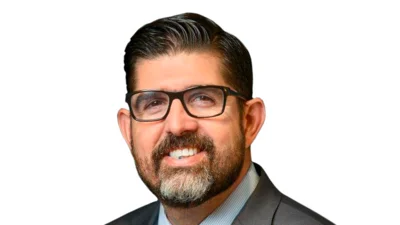Leaders of The Bolles School are thrilled to announce plans for the new Center for Innovation facility on the Bolles Upper School San Jose Campus. The 47,000-square-foot, three-story building marks the School’s most expansive construction undertaking since the completion of historic Bolles Hall in 1925.
Groundbreaking on the $25 million building, designed by Miami-based Zyscovich architects and constructed by Jacksonville-based Stellar design-build company, is expected to begin in June with construction taking two years or more to complete. The Center for Innovation was made possible by a generous gift from Frank Sanchez, whose $5 million landmark contribution is the largest single gift The Bolles School has received in its history.
“The Center for Innovation is an exciting work of both art and engineering, but like all campus structures, it exists to support the learning that happens within its footprint,” said Bolles President and Head of School Tyler Hodges. “In this case, this means collaborative hands-on learning, academic exploration with inspirational faculty and the ability for students to experiment and gain practical experience as they work toward their highest potential to serve our community and the world.”
The state-of-the-art structure is being constructed on the San Jose Campus’ last prime development site adjacent to Bolles Hall on a bluff overlooking the St. Johns River. The building will house Bolles’ science, math and technology programs, as well as expansive areas for advanced courses in robotics, computer programming, information technology, engineering and design. Designs for the facility accommodate opportunities for new offerings and provide space for collaboration and dialogue across disciplines. The new academic areas will deepen Bolles’ curriculum and cultivate the country’s next generation of innovators, according to department leaders.
"The new facility will bring renewed student engagement, innovation and ultimately, achievement, in all areas of science – exposing our students to an entirely new and exciting level of academics,” said Bolles Science Department Chair Nancy Hazzard. “Although the Center for Innovation will be a hallmark building like all campus structures, it will be an intellectual incubator for countless young minds who will serve and change our community as entrepreneurs, scientists, engineers, explorers and creative leaders.”
The Center for Innovation features numerous cutting-edge classrooms and 12 sophisticated specialty labs, including spaces for anatomy, biology and chemistry lab instruction. The building also will house Bolles’ Anatomage table, the world’s first and only virtual dissection table used by medical schools and universities around the globe. Bolles has long-been one of the few high schools in the country to offer students this college-level science resource. In addition to being built with the latest technology for advanced study, the Center for Innovation also will include spaces for small group discussions, collaborative learning and independent study. Faculty and School leaders felt strongly the building’s design should complement the School’s focus on real-world learning that allows students to create, invent and explore using a variety of tools, materials and technology. And it should also highlight the campus’ greatest natural asset – the St. Johns River.
“The ornate design was meant to be a living building bringing an abundance of windows and glass walls throughout,” said Bolles Associate Head of School Mike Drew. “Walls can move to make multiple classrooms into one big open room or open a classroom to the outdoors in many cases. We wanted to capitalize on the proximity of the building to allow all students to be inspired by the beautiful outside views of the river. Every floor has its own terrace and gathering place that encourages discussion, collaboration and creativity. As technology and science evolves the building will be able to evolve with it.”
Construction of the Center for Innovation, and the subsequent relocation of programs from classroom space in Bolles Hall and other buildings, also provides space for other areas of academic advancement and Resident Life – including the expansion of the new Llura “Lulie” Liggett Gund ’58 Residence Hall for Girls on the second floor of Bolles Hall. Once the Bolles math department moves into the Center for Innovation building, the residence hall can be expanded to accommodate 60 students – a big jump from its current 28-student capacity. This figure represents added space but does not denote an increase in student population overall.
Sanchez, whose gift made it possible to commence construction on the Center for Innovation, said the facility will cement The Bolles School’s future as one of the nation’s premier day and boarding schools. It is a tangible way to support student innovators, artists and athletes who represent 59 different countries and are committed to becoming future global leaders.
“Technology – including computer science and artificial intelligence, the environment, transportation and robotics – is evolving at an unprecedented pace,” Sanchez said. “Our education system needs to develop the next generation of academics and the young professionals who can support the demand.”
He applauded Bolles leaders for recognizing this opportunity and responding with a comprehensive program that centers on innovation – including a state-of-the-art facility to house it.
“This is a direction the high school curriculum needs to head and I am honored to participate with Bolles on this endeavor,” Sanchez said.
While the milestone Sanchez gift sets the Center for Innovation on a course for new construction and success, Bolles Chief Advancement Officer Carol Nimitz said the School continues to seek support for the ongoing development of the facility. The Bolles School needs an additional $12 million in philanthropic gifts to meet the $25 million cost of the building.
“We are humbled by and grateful for Frank Sanchez’ transformative gift to the School. It undoubtedly exhibits the School’s commitment to innovation and its tradition of academic excellence,” Nimitz said, adding she feels optimistic about ongoing fundraising endeavors. “Although we have not gone public with our fundraising efforts until now, the community is responding with enthusiasm to this special and historic opportunity.”
Original source can be found here.





 Alerts Sign-up
Alerts Sign-up